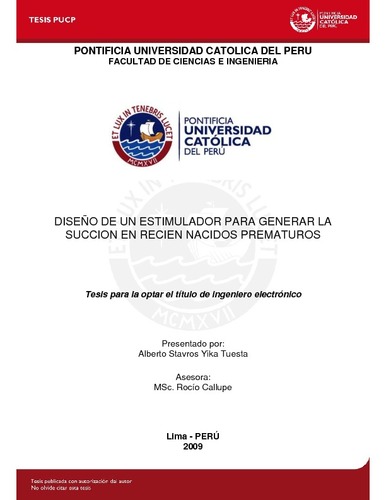| dc.contributor.advisor | Callupe Pérez, Rocío Liliana | es_ES |
| dc.contributor.author | Yika Tuesta, Alberto Stavros | es_ES |
| dc.date.accessioned | 2014-01-20T16:34:10Z | es_ES |
| dc.date.available | 2014-01-20T16:34:10Z | es_ES |
| dc.date.created | 2009 | es_ES |
| dc.date.issued | 2014-01-20 | es_ES |
| dc.identifier.uri | http://hdl.handle.net/20.500.12404/5070 | |
| dc.description.abstract | This work raises a solution for the development of the sucking reflex in premature infants. This
solution is based on a computer that uses a system of control of negative pressure applied directly in
a pacifier common through a dock. In turn, this process is performed using a generator of waves that
controls the frequency of suction as well as the kind of stimulation granted.
The systems of stimulation of suction in preterm infants are presented as the solution, in the face of
scarce stimulators of language, and the presence of latent problem. Currently, there are many
researches [2] that have collaborated with the development process of the language, which would
not only be measured patterns engines of non-nutritive sucking, but also produce a stimulator
natural and harmless with the proper frequency response.
The pacing system suction proposes stimulation based on control of a pneumatic motor and sensing
constant on a variety of parameters, which provide an effective and natural exercise, for newborns
in addition to cost reduction in the case of a treatment of short duration.
Therefore, this thesis aims to design a stimulator system based on the generation of vacuum and
inflated through a valve pneumatic, and sensing constant on a variety of parameters in order to
stimulate the newborn premature to assist in the development of non-nutritive sucking, which
directly affects their language .
The main conclusion it should be mentioned that it is possible to obtain all the patterns engines of
the suction non-nutritious to then use these in the construction of the signal generator of
stimulation in the system that was developed in laboratory conditions.
And it is important the contribution of this multidisciplinary work where unite two areas:
neuroscience and electronics, resulting in initiating investigations in the field of the neurocognitive
language disorder in children.
[2]. FINAN, DS., BARLOW, SM., The actifier: a device for neurophysiological studies of orofacial
control in human infants, Journal Speech Hear Research., vol. 39(4), pp. 833-8, Aug 1996. | en_EN |
| dc.description.abstract | El presente trabajo plantea una solución para el desarrollo del reflejo de succión en recién
nacidos prematuros. Dicha solución está basada en un equipo que usa un sistema de
control de presión negativa aplicada directamente en un chupón común mediante un
acople.
A su vez, este proceso se realiza usando un generador de ondas que controla la
frecuencia de succión así como el tipo de estimulación otorgada.
Los sistemas de estimulación de succión en recién nacidos prematuros se presentan
como la solución, ante la escasez de estimuladores del lenguaje, y la presencia latente del
problema. Actualmente, existen muchos trabajos de investigación [2] que han colaborado
con el proceso desarrollo del lenguaje, lo cual no solo mediría los patrones motores de la
succión no nutritiva, sino también producir un estimulador natural e inocuo con una
apropiada frecuencia de respuesta.
El sistema de estimulación de succión propone una estimulación basada en el control de
un motor neumático y el sensado constante de diversos parámetros, los cuales proveen
un eficaz y natural ejercicio, para los recién nacidos además reducción de costos al
tratarse de un tratamiento de corta duración.
Por lo tanto, este trabajo de tesis tiene como objetivo diseñar un sistema estimulador
basado en la generación de vacío e inflado mediante una válvula neumática, y el sensado
constante de diversos parámetros con la finalidad de estimular al recién nacido prematuro
para ayudar en el desarrollo de la succión no nutritiva, la cual afecta directamente su
lenguaje.
Como conclusión principal se debe mencionar que es posible obtener los patrones motores de la succión no-nutritiva para luego usar estos en la construcción de la señal
generadora de estimulación en el sistema desarrollado en condiciones de laboratorio. Y
es importante el aporte de este trabajo multidisciplinario donde se unen dos áreas:
neurociencias y electrónica, dando como resultado iniciar investigaciones en el campo
neurocognitivo del trastorno del lenguaje en el niño. | es_ES |
| dc.language.iso | spa | es_ES |
| dc.publisher | Pontificia Universidad Católica del Perú | es_ES |
| dc.rights | Atribución-NoComercial-SinDerivadas 2.5 Perú | * |
| dc.rights | info:eu-repo/semantics/openAccess | es_ES |
| dc.rights.uri | http://creativecommons.org/licenses/by-nc-nd/2.5/pe/ | * |
| dc.subject | Ingeniería biomédica--Aparatos e instrumentos | es_ES |
| dc.subject | Lactantes. | es_ES |
| dc.subject | Sistemas de control adaptativo | es_ES |
| dc.title | Diseño de un estimulador para generar la succión en recién nacidos prematuros | es_ES |
| dc.type | info:eu-repo/semantics/bachelorThesis | es_ES |
| thesis.degree.name | Ingeniero Electrónico | es_ES |
| thesis.degree.level | Título Profesional | es_ES |
| thesis.degree.grantor | Pontificia Universidad Católica del Perú. Facultad de Ciencias e Ingeniería | es_ES |
| thesis.degree.discipline | Ingeniería Electrónica | es_ES |
| renati.advisor.dni | 09534729 | |
| renati.advisor.orcid | https://orcid.org/0000-0001-5814-3926 | es_ES |
| renati.discipline | 712026 | es_ES |
| renati.level | https://purl.org/pe-repo/renati/level#tituloProfesional | es_ES |
| renati.type | https://purl.org/pe-repo/renati/type#tesis | es_ES |
| dc.publisher.country | PE | es_ES |
| dc.subject.ocde | https://purl.org/pe-repo/ocde/ford#2.02.01 | es_ES |






